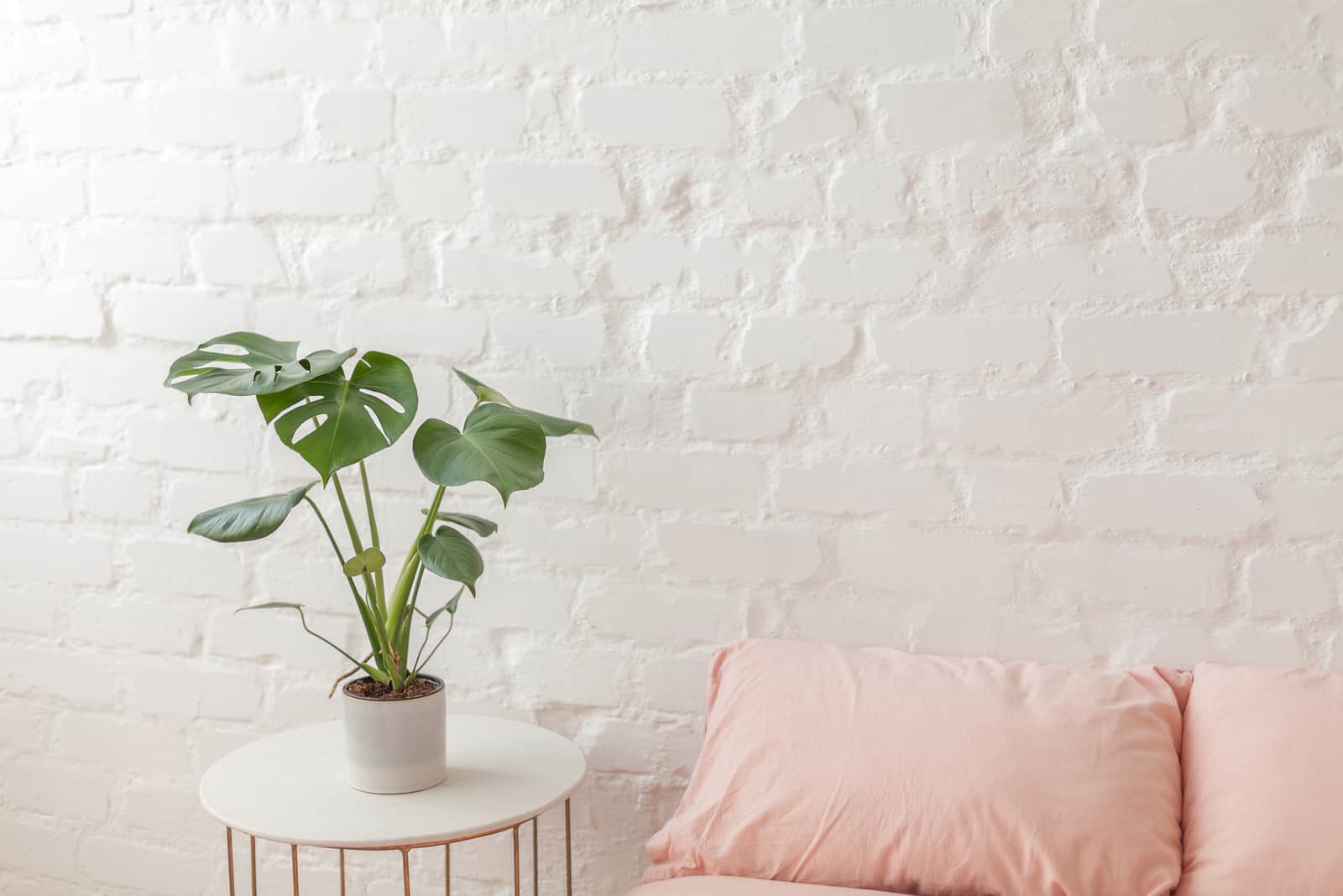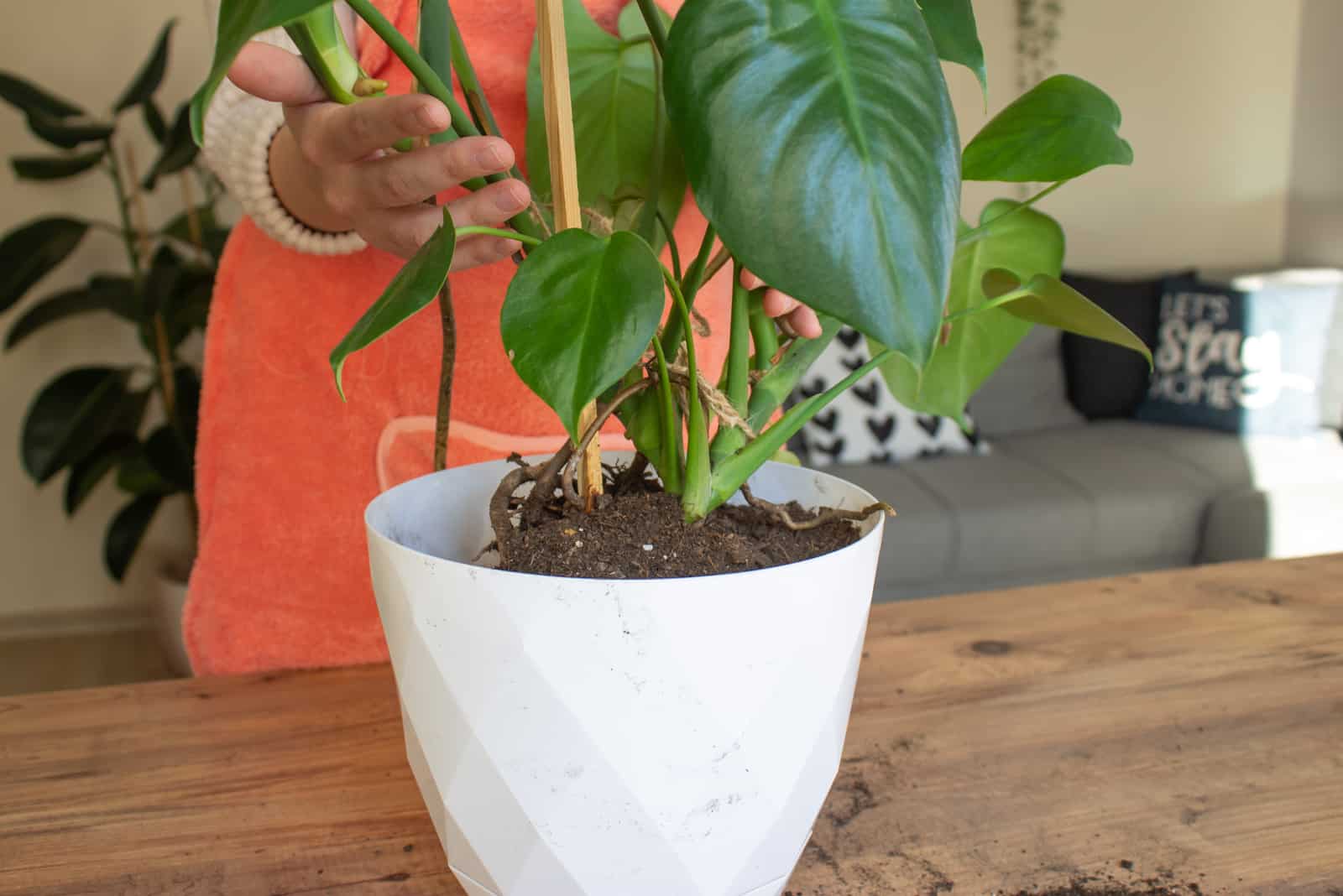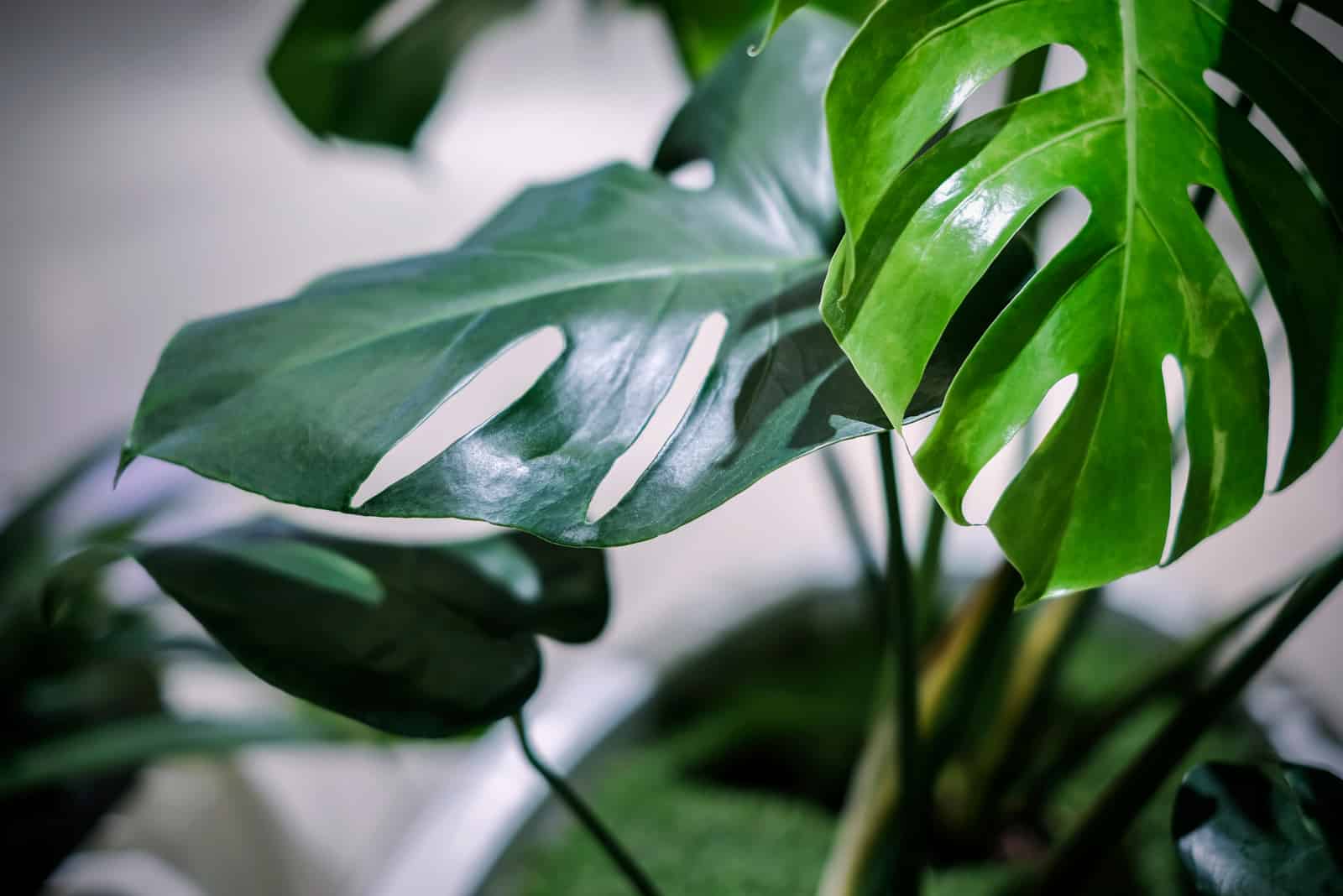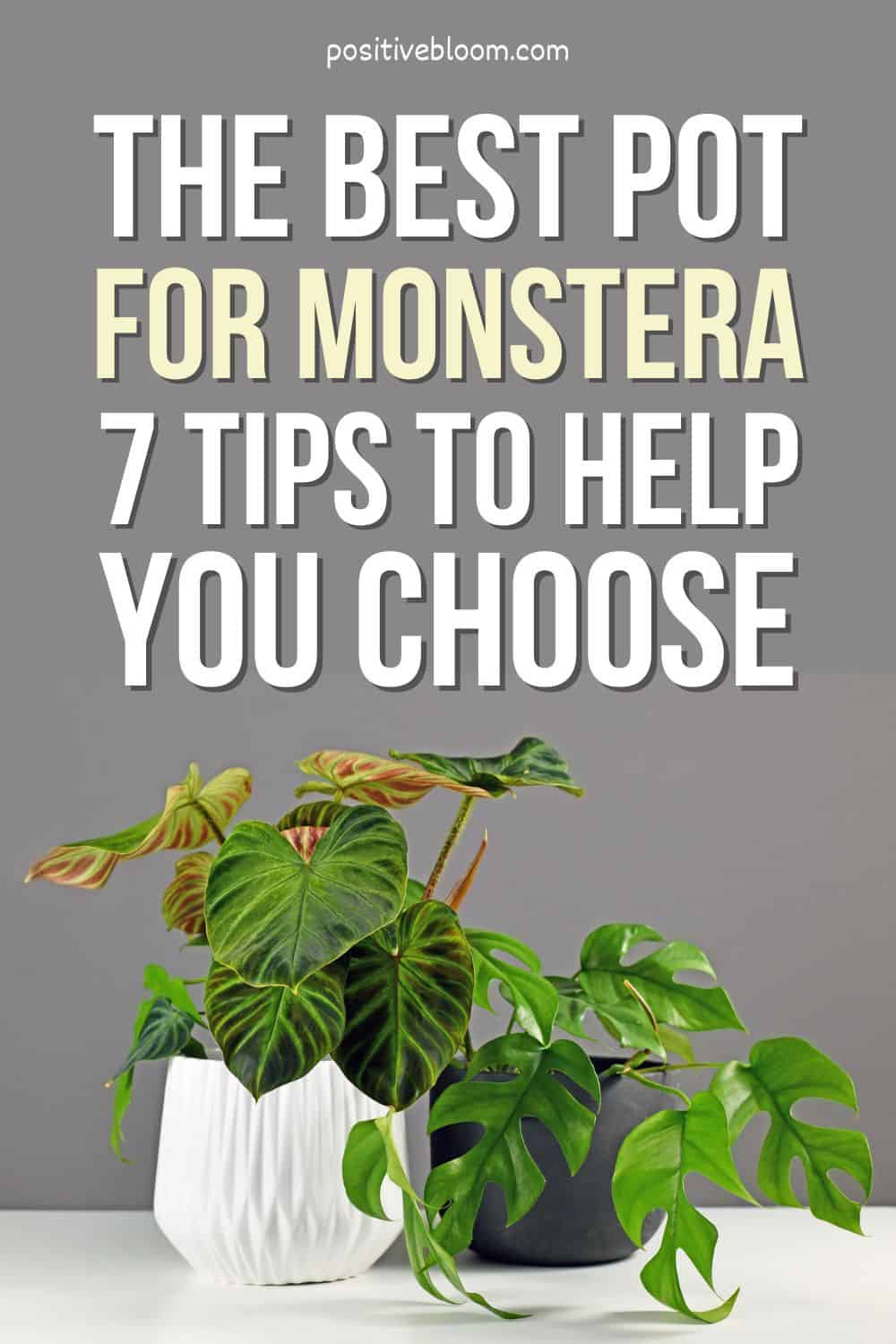Monstera houseplants are absolutely adorable, especially the mini ones! You can even make your plants look prettier by planting them in cute pots.
However, there are a few things you need to take into consideration aside from how the pots look. For instance, you have to make sure that they have drainage holes that allow proper soil drainage because Monstera’s are easy to overwater.
You have to also consider the material of the pot, whether it suits your Monstera plant, and the pot size.
Let’s find out what the best pot for Monstera plant is!
How To Choose The Best Pot For Monstera Plant
As we already mentioned in the introduction, you have to consider functionality over aesthetics. You don’t want to spend money on a pretty pot only to end up with one that won’t work for a monstera.
There are several factors you have to take into consideration:
• Watering habits
• Drainage
• Pot size
• Temperature
• Growing indoors or outdoors
• Pot material
We are now going to cover each of these in detail to help you find the right pot for your precious plant!
1. Watering Habits
There are two types of plant enthusiast out there: ones that overwater their plants and those that forget to water them! No matter which group you belong to, we have the solution for both cases!
The Monstera is a tropical plant that thrives in moist soil, so you will have to frequently water it. However, you can easily overwater it, which leads to root rot.
Luckily, you can put your plant in a pot that has the ability to either retain moisture or dry out pretty quickly. This is why pots are divided into porous and non-porous options.
Porous Pots
Porous pots are perfect for preventing overwatering. They have lots of tiny holes through which air and water can travel, so there will be no excess moisture retention. These usually include terracotta pots, concrete pots, or clay pots.
They come in many different colors and shapes.
Most of them have drainage holes at the bottom of the pot, are cost-effective, and easy to find. I got a pot for my Monstera marmorata for only a dollar from a thrift store!
With these types of pots, you won’t be able to see the roots of your plant. They aren’t waterproof either, so they can leave a stain if the water soaks through.
Non-porous Pots
Non-porous pots are made of waterproof materials and don’t allow air and water to pass through. They include stone, glazed ceramic pots, metal, fiberglass, resin, and wood pots.
If you forget to water your Monstera plant every now and then, these pots are great because they retain moisture well.
You can also find non-porous pots with drainage holes that are absolutely stunning and great for ornamental purposes. It is also hard to break them, which is perfect if you have kids and pets running around the house.
You cannot see the roots well with these pots, however. Also, metal can sometimes rust and ones made out of wood can rot, so choose wisely!
2. Drainage
Good drainage is the most important thing when choosing an appropriate pot for your Monstera houseplant. Drainage holes are important for removing excess water from the soil. If soil is soggy for too long, then your Monstera plant might begin to rot.
It’s always unfortunate when the prettiest pots don’t have drainage holes in the bottom. Isn’t life always like that?
However, you can always drill holes in pots that don’t have drainage holes (also known as cachepots).
Another way you can use cachepots for Monsteras is by putting them in a small plastic nursery before these types of pots.
Bear in mind that your plant pot must always have drainage holes.
3. Temperature
Temperature is an important part of choosing the best pot for Monstera plant as it greatly affects the water requirements.
For instance, if you keep your plant in a place with warm temperatures and low humidity levels, it will dry up quickly and require frequent watering. If the humidity levels are high, on the other hand, then your plant won’t need as much water because it can absorb it from the air.
If the temperature is low then the soil will take longer to dry out, which means that you won’t have to water your plant as much.
You will have to choose between non-porous and porous pots according to the temperature at which you are going to keep your plant.
However, in both cases you should use a pot with drainage holes and use well-draining potting soil.
4. Pot Size
Pot size is one of the most important things you must consider when choosing a pot for your Monstera plant. It’s hard to tell what the perfect size for your Monstera pot is because each plant is at a different life stage. Some varieties can also be bigger and therefore require a larger pot.
When your plant is still just a baby you will need a small pot — usually around 8 inches in diameter. As the plant grows it will need much more space, so you should repot it.
When repotting, choose a pot that is 2 inches larger than your current pot. The Monstera needs repotting once every 2 or 3 years, though this depends on its individual growth habits.
A mature Monstera plant might need a bigger pot — sometimes even 2 feet in diameter!
How To Tell If A Pot Is Too Big Or Small
The right size pot is crucial for your plant’s health. If the pot is too small your plant will become rootbound, which leads to stunted growth and underwatering symptoms. However, if your pot is too big there will be so much soil that it retains excess water.
If your pot is too small, repotting to a larger new pot is necessary!
Signs that your Monstera needs repotting include:
• Stunted growth
• Roots coming out of the holes in the bottom of the pot
• Monstera leaves are droopy
• Soil dries out too quickly
• The plant falls over to the side
Younger Monstera plants should always be repotted to larger pots because they need to grow and develop. Once your Monstera has matured and reached its optimal size (and you don’t want it to grow any larger), then you don’t have to repot it.
They tend to become rootbound, which can affect your plant’s overall health. Therefore, you should prune the excess of your plant’s roots to keep it happy and healthy!
If you notice any symptoms of overwatering, check if your pot is too big. In that case, repot your plant to a smaller pot.
Although it can be difficult to find the right pot for your plant, it’s definitely worth the trouble!
How To Repot A Monstera
You must first prepare a new pot before repotting your Monstera. I recommend going for one that is 1-2 inches larger than the previous one. Remove the old soil and sanitize the pot. Sterilization will prevent the transfer of diseases or pests to your precious plant. To help the soil drain any excess water, the pot should always have drainage holes.
It’s also crucial to get rid of any old soil from the roots.
Fill the pot with a third of your new potting mix, and use the leftover potting mix once you’ve placed your Monstera in the middle. Water immediately after repotting to let it settle in, and that’s it!
You can also check this video about repotting the famous Swiss Cheese plant, otherwise known as Monstera deliciosa:
5. Growing Indoors vs Outdoors
Although Monsteras are usually grown as indoor plants, some people like to grow mini jungles in their gardens, which is why they plant these tropical plants from the deepest rainforest.
You don’t have much control over this plant when it’s grown outside because weather conditions and climate influence its growth and requirements. For instance, if you live in an area with heavy rains you might need a pot with extra drainage holes in the bottom.
You might also want to consider adding perlite to the potting soil to aid with drainage during heavy rain. Cachepots must be avoided in this case, so you will need the porous kind of pot.
However, if the climate is warm and sunny where you live, you can plant your Monstera in a non-porous pot to help keep the soil moisture levels high. Plant it in terracotta or plastic pots and water it frequently.
If you live in a windy area you should put your plant in a heavy, weather-resistant pot because others, like plastic ones, can easily be blown away. You can also add rocks to the bottom, but it’s always better to bring your plant indoors during harsh weather conditions.
6. Pot Material
As we already mentioned, the most common pots for Monstera plants are made of terracotta, unglazed clay, plastic, and metal. The material is determined by the watering habits of your Monstera plants, so there isn’t much room for discussion
You have to give your plant what it needs.
Terracotta is probably the best material for porous pots because there are so many shapes and colors that can be used for decoration. However, you shouldn’t use these types of pots if your plant isn’t getting enough water.
Plastic cups are the most convenient option because they are light-weight and cost-effective, and you can also easily put them in any type of pot you want, whether it’s cachepots, terracotta, or clay.
You can also use the transparent plastic cups that are used for orchids. They are super convenient because you can see the aerial roots and soil, which makes it easy to spot when the plant is rootbound.
Brief Monstera Plant Care Guide
Let’s quickly go through a Monstera plant care guide to highlight the most important parts. For instance, soil mix plays a crucial role in the watering schedule of your Monstera, so you should consider it carefully when choosing the appropriate pot.
Let’s dive right in!
Soil Requirements
The Monstera prefers moist, well-draining soil that won’t cause root rot.
Similar to all philodendrons, the optimal potting soil consists of perlite, coco coir, sphagnum or peat moss, and universal aroid mix.
You can also use a cacti or succulent soil mix if you are concerned about overwatering your large plant.
Temperature Requirements
This is a tropical plant, so it thrives in warm temperatures.
As the Monstera isn’t frost hardy, it should be kept indoors during the winter. Temperatures between 65 and 75 degrees Fahrenheit are ideal for this plant.
You should also maintain a steady temperature because the Monstera is sensitive to temperature changes.
Light Requirements
Your monstera plant will flourish in bright indirect light.
Direct light should be avoided because it will burn the plant leaves and cause them to lose their distinctive variegation.
It does require some sunlight in order for its green leaves to accomplish photosynthesis, though.
The best place for this indoor plant is near a window, but not one that is exposed to direct sunlight throughout the day.
Water Requirements
Getting the watering habits for a Monstera plant right can be tricky because you have to give them enough water to keep the soil moist, but also avoid overwatering.
This plant doesn’t enjoy either wet or dry soil for extended periods of time.
Before watering, check to see if the soil has completely dried with your thumb or some wooden chopsticks.
The soil will dry quickly during the summer and take longer to dry out during the winter, so it will need to be watered more frequently during the summer.
Make sure the water reaches the roots and remove any excess water from the bottom of the pot.
This will ensure that your plant receives the exact amount of water it requires to stay healthy and happy!
Humidity Requirements
This is a tropical plant, so it prefers higher humidity levels (just imagine how humid deep rainforests are!).
If you live in a low-humidity area, don’t worry because this plant can withstand low humidity. Make sure it doesn’t get below 40% humidity, though, otherwise the leaves will become brown and crunchy.
It’s better to keep levels around 65 percent or higher. To obtain this level, you might need to buy a humidifier or mist the plant.
Fertilizer Requirements
When it comes to fertilizer, the Monstera isn’t picky. You can use universal fertilizer to provide just enough nutrients for your plant to flourish!
If you live in an area where there is no winter or cold weather, fertilize the plant once a month to keep it growing.
However, because the growing season is significantly shorter in colder climates, you should only fertilize it once a month throughout the growing season!
Pruning
The leaves are the most unique feature of this plant, so regular pruning should be avoided.
Only remove the leaves if they are damaged or turn brown or yellow.
A Monstera plant’s size is determined by how it was cultivated. Some types, such as the Monstera Marmorata, can reach a height of 18 feet if planted outside!
It’s much smaller indoors, though, and can be cultivated in hanging baskets and pots. The Monstera adansonii looks absolutely adorable hanging from baskets!
In most cases, the plant will adapt to its surroundings and develop in accordance with the resources available.
As this is a climbing plant, you will need to give it some sort of support like a moss pole to help it develop. This will aid in the growth of larger and more fenestrated leaves!
Pruning is usually done in early spring so the plant can recover and grow for the rest of the season.
Propagation
If you want lots of monstera babies all over your house, you’ll be delighted to hear that you can propagate this plant!
Monstera propagation is a beginner friendly process and it can be done by stem cuttings. You can propagate your plants in either water or soil, the choice is yours. The outcome is the same for both.
Make sure the stem has healthy leaves and nodes before cutting it, then submerge the node in water or bury it in soil.
If you’re going to use soil, make sure it’s damp. Overwatering should be avoided and your little monster should be kept somewhere warm and damp.
If you’re planning to use water, make sure to replace it once a week and store it somewhere bright. You can plant it in soil once the roots develop to about 3 inches long.
Common Problems
The arch nemesis of your Monstera plant is inadequate watering. Overwatering can lead to root rot and the eventual death of your plant. Underwatering will dry the root ball and stunt its growth and development.
Another common issue is pests. Despite the fact that your plant is a monster, it can be infested by small insects and bugs, and once they infest your plant they spread like crazy!
To keep them from making a home out of your lovely plant, spritz it with water or insecticide. Neem oil can also be used to repel them – simply sprinkle it all over the plant, especially the leaves.
You Asked Us…
1. Do Monsteras need soil?
Yes, they need soil. Monsteras will thrive in well-draining and moist soil as they originate from tropical areas! The best potting soil mix consists of perlite, coco coir, sphagnum or peat moss, and universal aroid mix.
You can also use a cacti or succulent soil mix if you have some lying around.
2. Are terracotta pots good for Monsteras?
Yes, they are good for Monsteras that get plenty of water!
If you tend to overwater your plants, then terracotta pots are the best option for you. They are the porous kind of pots that have tiny holes that air and water can escape through. This prevents the water retention that can lead to root rot.
3. What kind of pot is best for a Monstera?
The best pot for Monstera has drainage holes in the bottom and is made of appropriate material. You should buy a non-porous pot if you sometimes forget to water your plants because they are made out of material that helps with moisture retention.
However, porous pots have tiny holes that allow for air and water to pass through. This means that they will dry quickly and not retain moisture.
I usually use terracotta pots because to me they are simply the best!
Conclusion
The best pot for monstera plant has to be the right size, have drainage holes, and be made of appropriate material according to the watering requirements!
You can always find decorative pots, whether they are porous, non-porous, or made out of plastic, terracotta, clay, concrete, or anything else.
Sure, you can always use cachepots, but make sure to drill drainage holes at the bottom or use plastic cups instead.
Don’t forget to repot your Monstera plant when it gets rootbound, especially if it is a young plant that is still developing.
Be careful about watering as these plants can easily be overwatered!
I hope this article was helpful. 🙂
Until next time!
Like this post? Share or pin it for later!





